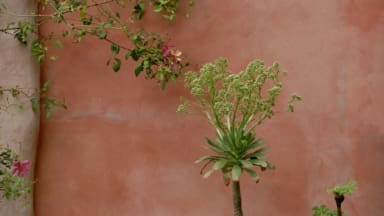
In her article for Gardens Illustrated, the multi-award winning garden designer Ann-Marie Powell outlines what’s in and what’s out in gardens and garden design for the new year.
- The outdoor ‘sitting’ room – An extension on the ‘outdoor room’, Powell quotes Octavia Hill, the social visionary and co-founder of the National Trust – whom along with the National Trust and Bluewater, she is celebrating by means of an RHS Chelsea 2024 show garden. Think (more) comfortable seating amidst pollinator friendly planting to create a place that offers “a fresh perspective and appreciation for the environment”, writes Powell.
- Texture in the hard landscaping – Textured surfaces are replacing “the stark uniformity of sawn, smooth paving, rendered walls and precision stainless steel”, writes Powell. According to the designer, material choices are heading to characterful timber, textured render, riven paved stones, terracotta, ceramics or encaustic tiles to provide pattern, contrast and depth in garden designs. Traditional English craftsmanship and natural materials are at the top of the list.
- Xeriscaping – Defined as the process of landscaping/gardening that reduces and/or eliminates the need for irrigation. Opting for drought resistant plants can help mitigate the effects of climate change and help gardens thrive in ever increasing temperatures. According to Powell, xeriscaping is already a big trend in the US and expected to take hold in the UK. With the onset of warmer climates, nurseries too are working to provide more plant species for long term temperature resilient, low(er) maintenance gardens that are still/more aesthetically pleasing.
- Gardening in sand – An intriguing trend, which Powell thinks is fast gaining momentum as an innovative planting method which produces sturdier more resilient plants requiring no/less staking and less molly-coddling. Leading gardeners such as John Little, Peter Korn, James Hitchmough, Nigel Dunnett, Charlie Harpur and Jimi Blake are planting in sand so this definitely a trend to keep an eye on. Sand is also a byproduct from the building trade, making this an even more attractive option.
- ‘Good Life’ gardening – Not strictly new, but perhaps with added momentum is the trend to rebel from the supermarkets and embracing a degree of self-sufficiency. According to Powell we shall be seeing more “edimentals (ornamental edibles), cutting gardens, poly-tunnels, greenhouses, gardeners paths in borders, compost areas, hotbeds, pot stores, sheds and herb gardens. She writes that “gardens are no longer places to look at, they’re places to live in, and you can have a piece of the good life, support the delicate chains of the natural order whether you have a couple of acres or a few pots by the door, on the balcony or the windowsill”.
- Environmentally conscious gardening – Sustainable gardening is a big trend and becoming ever more sophisticated with features such as natural ponds, natural swimming pool and water features for the ample wildlife opportunities they provide. Powell adds that elements such as rain borders, natural water runoff systems, water collection methods such as water butts will become more prevalent as will the usage of ‘Sustainable Urban Drainage System’ (SUDS) compliant materials. Homemade compost, ‘chop and drop’ mulching method (dead spring top growth is cut back and strewn straight onto the soil), wildlife beneficial plant choices and of course pesticide and chemical free gardening are key.
- Warm toned materials – Sarah Price’s 2023 RHS Chelsea ‘The Nurture Landscapes Garden (pictured) has definitely made its mark. According to Powell, there is a “clear departure from clean whites, cold steel and uniform greys” as contemporary garden design is embracing warmer shades and heritage materials. Terracotta, bronze, copper, rust, oatmeal, hazel, and biscuit are some of the colours Powell states will be appearing in hardscape selections.
- Ecological design – Powell says that clients are increasingly requesting “less manicured” gardens to embrace wildlife and reduce maintenance requirements. Ecological design involves the creation of sustainable gardens, consisting of a mix of native and non-native plants for optimum biodiversity, perennial wildflower meadows, native hedging, and nectar-rich planting. “I believe this shift towards a more ecologically responsible, natural approach reflects a deeper appreciation, and a respect for the joy of gardening, which I’m sure you find as thrilling as I”, writes Powell.
- Repurposing materials – According to Powell designers, including her own practice are increasingly respecting existing hardscape elements and repurposing/reusing materials whenever possible. If that’s not possible, locally sourced with reduced-carbon footprint is the way forward, as is ensuring the design, layout and construction detailing stands the test of time.
- If paved areas have deteriorated to such a point where crushing is the only option, these will be used as sub-bases for new stone, used as informal paths, or as a planting substrate where they old materials can be laid to rest adorned by bountiful, colourful self-seeders.
- Bold planting – Bringing joy into the garden is a trend the RHS also advocates for mental and physical wellbeing by means of creating inviting and exciting spaces “that encourage people to revisit and immerse themselves in the beauty of nature to bring joy throughout the seasons”, writes Powell.

